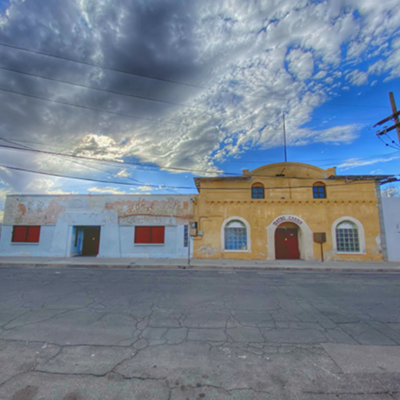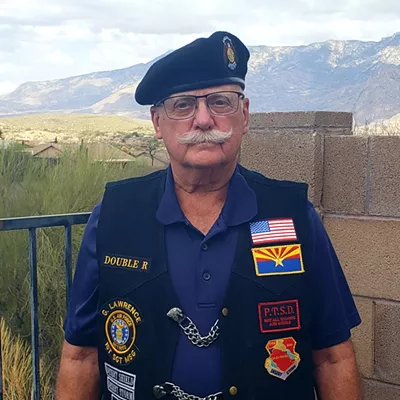"IT WOULD BE lovely if the project could be lovely," Jacky Turchick says of the proposed Arroyo Chico detention basin project. Sitting on the front porch of her home near Park Avenue and Broadway Boulevard, Turchick looks out over the anticipated site of the project's primary basin as it is framed by the rugged peaks of the distant Santa Catalina Mountains.
"I want to see a clean arroyo, as natural as possible, since there's not much of that left in the city," she explains. "I'm in favor of reasonable flood control projects. But drinking water could be impacted (by the project) without pollution remediation, and if that happens, the city is in trouble."
The $14 million, five-basin project (see "Urban Watershed," March 23), which has been under consideration since the early 1990s, would border the existing Arroyo Chico from Campbell Avenue west to Park. It is intended to protect hundreds of homes and businesses along with downtown streets from flooding.
The project could, however, help spread existing pollution from underneath the proposed primary basin. That has Turchick and other members of the Arizona Department of Environmental Quality's Park-Euclid Community Advisory Board concerned. They are particularly worried about the pollutants, including tetrachloroethene (PCE) and trichloroethene (TCE), possibly moving north toward wells serving the nearby University of Arizona.
The potential migration of these pollutants was mentioned in a recently released Draft Supplemental Environmental Assessment prepared by the Army Corps of Engineers, the lead agency on the detention basin project. It stated, "The preliminary modeling study indicated that the possibility exists that groundwater contamination ... could potentially impact the potable water wells to the north."
Brooks Keenan, director of Pima County's Transportation and Flood Control Department, doesn't believe water infiltration from the project will affect groundwater. "That won't happen because the basins will be dry almost all of the time and there's no extra infiltration if there is no water," he says. "They will only have water in them after a once-in-every-10-year storm, and then only for a few hours. So there won't be a lot of recharge from the basins."
The Corps of Engineers draft environmental assessment agrees. It states, "Existing data does not indicate that (the project) would have any significant adverse impact on the migration of the existing contaminant plume."
Turchick and other members of ADEQ's community board aren't that confident. They want to see data on infiltration rates from the basins before deciding. In commenting on the Corps document, the group unanimously agreed to conclude, "The infiltration testing data does not support the conclusions set forth. ... The (Community Advisory Board) believes it is necessary to have strong assurances that infiltration from the basins ... will not adversely affect the distribution of contaminants or their remediation ... ."
In response, Pima County's Keenan, while acknowledging that the board was doing its job, says the members have received more education about pollution in the area than about how the basins will operate. Despite that, Pima County is about to employ a consultant to study the basin infiltration question, and Keenan expects results within six months.
Also about to be studied more thoroughly is the actual pollution in the ground under the primary basin. While ADEQ has been investigating the site since 1990, it now hopes to have monitor wells in place by the end of December; these will collect data for up to two years. The results from these test wells will help to develop a pollution remediation plan, something that probably won't be finalized until the end of 2002.
Because of the timing, the ADEQ citizen board said in its recent letter to the Corps that it "does not understand why the detention basin project should be started before the remediation plan has been determined."
"We have time," Jacky Turchick says of basin construction. "We don't have to rush."
Board member Keith Bagwell goes further. He believes the Corps, the County and the City are putting "the cart before the horse and it looks suspicious. The only rational thing," he says, "is to determine the extent of the pollution and design a remediation plan" before installing the basins. But Bagwell believes pressure to complete the basins before construction on downtown's last mile of the Barraza/Aviation Parkway is started within the next few years is driving the timing of the project.
The Army Corps of Engineers did not respond to the Weekly's request for a comment on the advisory board's concerns. Pima County's Keenan, however, says detailed design of the basins should begin next month and be finished by early 2002, with an 18-month construction period to follow.
When asked why the design would begin before either the infiltration study or pollution remediation plan are completed, he replied, "Since it will take a up to a year and one-half to complete the plans, we will have knowledge from the infiltration study well in advance and will have plenty of time to incorporate that information. Our understanding, though, is there just cannot be a lot of groundwater recharge from the basins."
As for waiting over two years until the ADEQ remediation plan is completed before finalizing the design of the basin project, Keenan says, "The cleanup can proceed even though the basins are constructed. There's nothing incompatible with the plans for the basins and the remediation effort. There are several sites which have been identified for both monitoring and remediation wells. There is no conflict" if project construction goes ahead as scheduled.
While ADEQ's community board continues to question the Corps and the County, the City of Tucson's Citizens Advisory Committee, which was appointed to oversee the design of the basin project, has apparently been completely shut out of the process. This group's recommendations resulted in the Corps and County substantially redesigning the project some time ago. But the most recent design changes haven't even been shown to the group.
"There has been no citizen input whatsoever on the latest plans. There haven't been citizen comments on the design in the last two years," committee chair Corky Poster laments. City of Tucson Transportation Department officials admit dropping the ball with the committee.
"It's sort of like a black hole; our recommendations went in and not much has come out," Poster says of the project design process. "They did manage in a broad sense to comply with our recommendations, but I'm nervous about project implementation without citizen oversight. I'd like to trust them but I don't know if I can."









